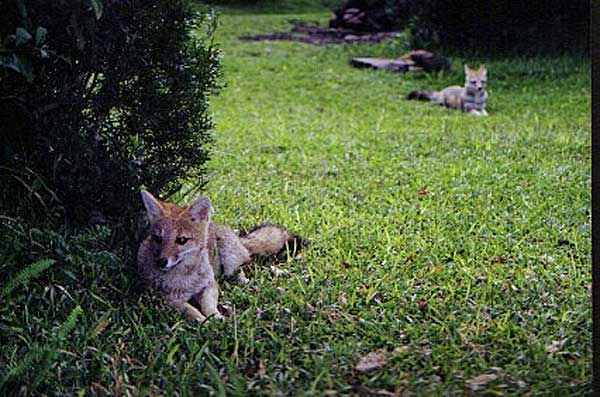Lycalopex gymnocercus (*) Cladus: Eukaryota Name Lycalopex gymnocercus (G. Fischer, 1814) Type locality: "Paraguay", restricted by Cabrera (1957) to "a los alrededores de Asunción." Synonyms * Pseudalopex gymnocercus (G. Fischer, 1814)
* Fischer [Von Waldheim], G. 1813-1814. "Zoognosia tabulis synopticis illustrata." Nicolai Sergeidis Vsevolozsky, Moscow, 3 vols [3-1814].
The Pampas fox (Lycalopex gymnocercus), also known as graxaim, sorro, Azara's fox, or Azara's zorro, is a medium sized zorro or "false" fox native to South American pampas and its range is through central South America in Argentina, Uruguay, Paraguay and Brazil. Several of the alternative common names are references to Spanish naturalist Félix de Azara.
The Pampas fox resembles the culpeo, but is smaller and gray in color with black mark on the muzzle. It has short, dense fur that is gray on the back and underparts. The head and neck are reddish, and the ears are triangular, broad and relatively large; it is reddish on the outer surface and white on the inner surface. In the northern part of its range, the Pampas fox is more richly colored than in the southern part. The Pampas fox weighs 9 to 12 pounds. The males are approximately in 10% larger than females. Distribution and habitat The Pampas fox can be found in the Southern Cone Pampas in Argentina, Uruguay, Paraguay and Brazil. It prefers grasslands, forest and valleys and prefers various open habitats in its range. Behavior The Pampas fox mostly lives a solitary life, but comes together in the breeding season to raise and care for its young. If a threatening or larger animal comes near it is known to play dead with its eyes closed and will stay there until the animal leaves. It is mainly nocturnal, becoming active at dusk, although sometimes it is active during the day in areas with little human habitation. It mainly spends its time in high grassland and thicket when hunting its prey. Reproduction It prefers relatively solitary lifestyle, but sometimes live in monogamous pairs. Pregnant females hide in dens that are among bushes or at the base of trees. After a gestation period of 55 – 60 days, the mother gives birth to 3-5 kits. Pups will hunt with parents when they are 3 months old. The males bring food to their females which stays at the den with kits. The Pampas fox eats plants, birds, rodents, fruits, rabbits, frogs, lizards, sometimes lambs, carrion, eggs, and invertebrates. Approximately 75% of its diet consists of rodents, rabbits and birds. It is considered an omnivorous canid and sometimes attacks domestic livestock. The main threats to the Pampas fox comes from humans hunting it for its skin. It is killed to prevent it from attacking livestock. Subspecies There are five recognized subspecies of this zorro:[1] Lycalopex gymnocercus gymnocercus References ^ a b Wozencraft, W. Christopher (16 November 2005). "Order Carnivora (pp. 532-628)". In Wilson, Don E., and Reeder, DeeAnn M., eds. Mammal Species of the World: A Taxonomic and Geographic Reference (3rd ed.). Baltimore: Johns Hopkins University Press, 2 vols. (2142 pp.). ISBN 978-0-8018-8221-0. OCLC 62265494.
Source: Wikipedia, Wikispecies: All text is available under the terms of the GNU Free Documentation License |
|


